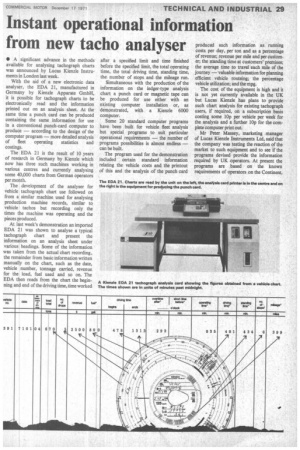Instant operational information from new tacho analyser
Page 31

If you've noticed an error in this article please click here to report it so we can fix it.
• A significant advance in the methods available for analysing tachograph charts was announced by Lucas Kienzle Instruments in London last week.
With the aid of a new electronic data analyser, the EDA 21, manufactured in Germany by Kienzle Apparate GmbH, it is possible for tachograph charts to be electronically read and the information printed out on an analysis sheet. At the same time a punch card can be produced containing the same information for use in a conventional punch-card computer to produce — according to the design of the computer program — more detailed analysis of fleet operating statistics and costings.
The EDA 21 is the result of 10 years of research in Germany by Kienzle which now has three such machines working in various centres and currently analysing some 40,000 charts from German operators per month.
The development of the analyser for vehicle tachograph chart use followed on from a similar machine used for analysing production machine records, similar to vehicle tachos but recording only the times the machine was operating and the pieces produced.
At last week's demonstration an imported EDA 21 was shown to analyse a typical tachograph chart and present the information on an analysis sheet under various headings. Some of the information was taken from the actual chart recording, the remainder from basic information written manually on the chart, such as the date, vehicle number, tonnage carried, revenue for the load, fuel used and so on. The EDA then reads from the chart the beginning and end of the driving time, time worked after a specified limit and time finished before the specified limit, the total operating time, the total driving time, standing time, the number of stops and the mileage run.
Simultaneous with the production of the information on the ledger-type analysis chart a punch card or magnetic tape can be produced for use either with an existing computer installation or, as demonstrated, with a Kienzle 6000 computer.
Some 20 standard computer programs have been built for vehicle fleet analysis but special programs to suit particular operational requirements — the number of programs possibilities is almost endless — can be built.
The program used for the demonstration included certain standard information relating the vehicle costs and the printout of this and the analysis of the punch card produced such information as running costs per day, per ton and as a percentage of revenue; revenue per mile and per customer; the standing time at customers' premises; the average time to travel each mile of the journey — valuable information for planning efficient vehicle routeing; the percentage vehicle utilization; and the mpg.
The cost of the equipment is high and it is not yet currently available in the UK but Lucas Kienzle has plans to provide such chart analysis for existing tachograph users, if required, on a subscription basis costing some 10p per vehicle per week for the analysis and a further 10p for the complete computer print out.
Mr Peter Massey, marketing manager of Lucas Kienzle Instruments Ltd, said that the company was testing the reaction of the market to such equipment and to see if the programs devised provide the information required by UK operators. At present the programs are based on the known requirements of operators on the Continent.
































































































